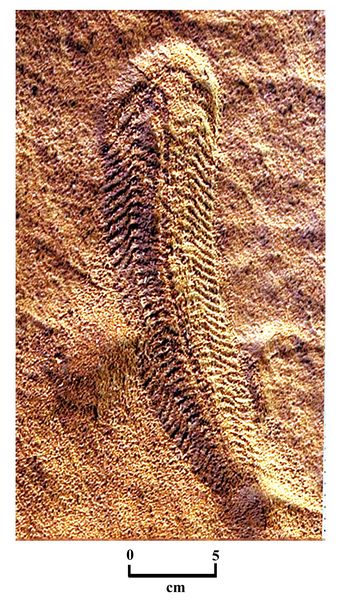Athena Review Image Archive ™
Ediacaran fauna in Australia

Spriggina floudersi from Ediacara, Australia (after Wade 1968 ).
The Ediacaran is the last stage of the Precambrian period, dated 635-542 mya, and named for the Ediacara Hills in Australia where many fossils from the period have been found. The Ediacaran overlaps in time, and is partly a synonym for the Vendian stage, named for a fossil-rich region in Russia.
The Ediacaran biota is exceptional in that organisms lacking hard parts were preserved in medium-coarse sandstone deposits. Opinion is not yet resolved on what original body structures and/or taphonomic processes may have caused this (Conway Morris 1998). The Ediacaran fauna, in any, case, respresent the oldest known group of multicellular organisms with tissues. Some of the most common types found at Ediacara, and at contempary sites in Nova Scotia, resemble present-day disk-shaped jellyfish.
Such disk forms are marked either with internal lines (e.g., the genera Arkarua, Dickensonia, Marywadea, and Yorgia), or concentric circles (Ediacaria). Other Ediacaran fossils resemble fronds of kelp-like seaweed with holdfasts or root-like anchors (Charnia). There also appear to have been segmented organisms. Spriggina floudersi had a segmented body of 3-5 cm length, and may have been predatory. Its bottom is covered with two rows of tough interlocking plates, while one row covered its top or dorsal surface. Its first two front segments fused to form a head. The front segment was the shape of a horseshoe, with a pair of depressions on its upper surface which may represent eyes. The second segment may have borne antennae. Subsequent segments bore ring-like forms or annulations.
While one or two of the Ediacaran taxa may have lasted into the Middle Cambrian and were found in the Burroughs shale, there is little overall continuity with the Cambrian, and no evidence of primitive notochords.
References:
Glaessner, M.F. and B. Daly 1959.Geology and Late Cambrian Fauna of the Ediacara Fossil Reserve. Rec.S.Austral.Mus.13.
Spriggs, R.J. 1947. Early Cambrian (?) Jellyfishes from the Flinders Ranges; South Australia. Trans.Royal Soc.S.Austral.71; pp.212-224.
Wade, M.J. 1968. Preservation of soft-bodied animals in Precambrian sandstones at
Ediacara in South Australia. Letheia 1; pp. 238-267.
Copyright © 1996-2020 Rust Family Foundation (All Rights Reserved).